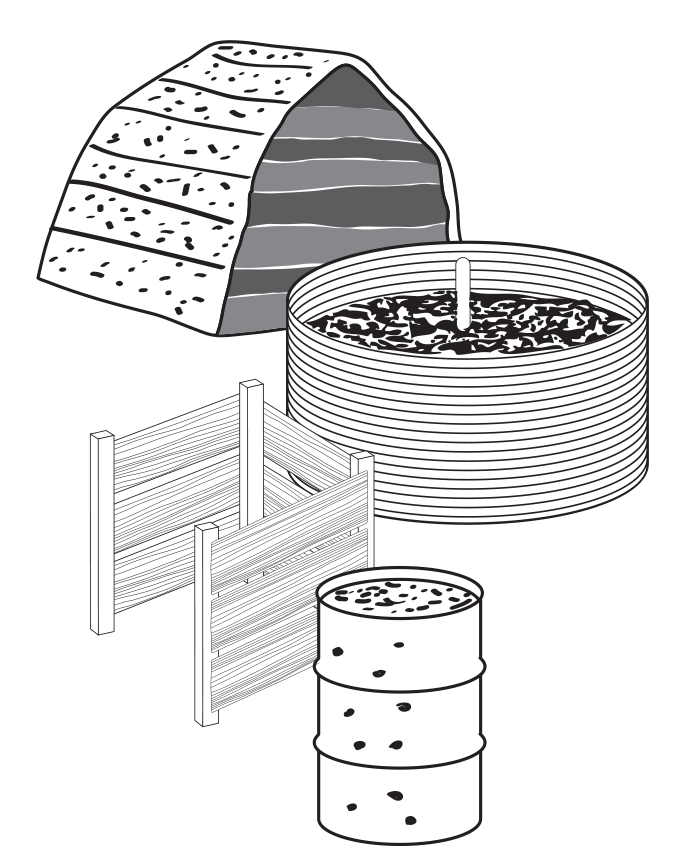Decomposition is a fundamental process in which all life depends. We’d all be knee deep in garbage without it! Bacteria, fungi, and other microscopic organisms that live in the soil, air, and water are responsible for turning once-living plants and animals into nutrients that can be used again and again. Think of these organisms as nature’s recyclers. They have the ability to produce special enzymes that allow them to break down dead plants and animals and use them as food. No job is too big; they quickly enlist the help of friends and family. As they eat, many microorganisms grow and multiply at an amazing rate—in just four hours, one bacterium can grow to a colony of 5,096. At day’s end, there are millions and billions of them working together. Why, in a teaspoon of soil, there are more bacteria and fungi than all the people on Earth! Despite their microscopic size, you’ve probably seen evidence of them right in your own home. Remember that orange and blue-green mold in the back of the refrigerator? Or that black or white fuzzy slice of bread? These are colonies of our microbial friends hard at work practicing the fine art of decomposition.
Composting takes advantage of microbial decomposition to turn farm, garden, and kitchen wastes into a nutrient-rich soil amendment. Some dairy and poultry farmers compost the manure from their animals and sell it, turning waste into profits. Many gardeners throw kitchen scraps and weeds into the compost, turning waste into fertilizer for next year’s garden. Adding compost to the soil provides nutrients to plants, improves soil structure, and increases the water-holding capacity of the soil.
 Many types of containers are suitable for making compost—they just need to be accessible, resist decay, and allow air flow. How do you decide which container will work best? Consider the amount of time and space you have, and the quantity of materials you will be composting. Most compost containers fall into one of these categories: heaps (simple, stacked piles), hoops (caged enclosures), bins (boxed enclosures), and barrels (drum enclosures). For fast, hot compost, the ideal pile size is 1 cubic yard (3' x 3' x 3'). This volume effectively retains the heat generated by the bacteria. The volume of a single pile should not exceed 2 cubic yards in order to maintain proper ventilation of the pile. If space is a limiting factor, the pile sides can be insulated to maintain high temperatures in a smaller volume. Compost temperatures of 135–160°F speed decomposition and kill pathogenic organisms, flies, and weed seeds. In a well-built compost pile with proper ventilation and moisture, the activity of decomposers will provide this heat without any problem.
Many types of containers are suitable for making compost—they just need to be accessible, resist decay, and allow air flow. How do you decide which container will work best? Consider the amount of time and space you have, and the quantity of materials you will be composting. Most compost containers fall into one of these categories: heaps (simple, stacked piles), hoops (caged enclosures), bins (boxed enclosures), and barrels (drum enclosures). For fast, hot compost, the ideal pile size is 1 cubic yard (3' x 3' x 3'). This volume effectively retains the heat generated by the bacteria. The volume of a single pile should not exceed 2 cubic yards in order to maintain proper ventilation of the pile. If space is a limiting factor, the pile sides can be insulated to maintain high temperatures in a smaller volume. Compost temperatures of 135–160°F speed decomposition and kill pathogenic organisms, flies, and weed seeds. In a well-built compost pile with proper ventilation and moisture, the activity of decomposers will provide this heat without any problem.
Once you have selected the container and location for your compost pile, remember the simple formula: 1 part green (fresh grass clippings, kitchen scraps, etc.) to 2 parts brown (straw, aged manure, dry leaves, etc.). Please note that no meat or dairy items should be included because they can potentially introduce harmful bacteria that will not only stink, but that also have the potential to make people sick. Layering helps the pile to get going, but stirring the pile is important and will accelerate the decomposition of your dead plants and scraps into beautiful, earthy smelling (not stinking) compost.
 Many types of containers are suitable for making compost—they just need to be accessible, resist decay, and allow air flow. How do you decide which container will work best? Consider the amount of time and space you have, and the quantity of materials you will be composting. Most compost containers fall into one of these categories: heaps (simple, stacked piles), hoops (caged enclosures), bins (boxed enclosures), and barrels (drum enclosures). For fast, hot compost, the ideal pile size is 1 cubic yard (3' x 3' x 3'). This volume effectively retains the heat generated by the bacteria. The volume of a single pile should not exceed 2 cubic yards in order to maintain proper ventilation of the pile. If space is a limiting factor, the pile sides can be insulated to maintain high temperatures in a smaller volume. Compost temperatures of 135–160°F speed decomposition and kill pathogenic organisms, flies, and weed seeds. In a well-built compost pile with proper ventilation and moisture, the activity of decomposers will provide this heat without any problem.
Many types of containers are suitable for making compost—they just need to be accessible, resist decay, and allow air flow. How do you decide which container will work best? Consider the amount of time and space you have, and the quantity of materials you will be composting. Most compost containers fall into one of these categories: heaps (simple, stacked piles), hoops (caged enclosures), bins (boxed enclosures), and barrels (drum enclosures). For fast, hot compost, the ideal pile size is 1 cubic yard (3' x 3' x 3'). This volume effectively retains the heat generated by the bacteria. The volume of a single pile should not exceed 2 cubic yards in order to maintain proper ventilation of the pile. If space is a limiting factor, the pile sides can be insulated to maintain high temperatures in a smaller volume. Compost temperatures of 135–160°F speed decomposition and kill pathogenic organisms, flies, and weed seeds. In a well-built compost pile with proper ventilation and moisture, the activity of decomposers will provide this heat without any problem. Introduce the vocabulary words to the students. Assess their prior knowledge by asking a series of questions such as:
Introduce the vocabulary words to the students. Assess their prior knowledge by asking a series of questions such as: